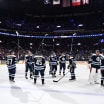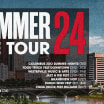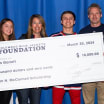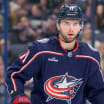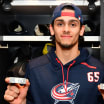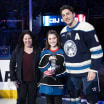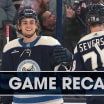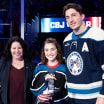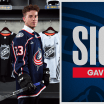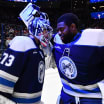CLINTON, N.Y. - Pick out any NHL hockey player, put a blindfold on him and lead him into the rink where he spent the most time as a kid.
Odds are, in a matter of seconds, his other senses will tell him exactly where he's standing.
Maybe it's the smell of popcorn coating the beams that hold the rink together. Maybe it's his shoes sticking to the beer-stained concrete. Maybe it's the feel of open air and snowflakes on his face or the sound of a puck smacking into the boards only the way it does in that very rink.
The Zamboni driver's voice, the distinct way shots echo off the crossbar, the sounds that reverberate from a low-slung ceiling … yep, that rink is his own. That ice means he's home - and he'll know it.
It's probably the place he first laced up skates and felt the thrill of a successful stride. It's where he first passed a puck, took a face-off, scored a goal or made a save.
No matter the player - or coach, scout or general manager - all have their own home rink somewhere out there, from the farthest outposts of Alaska to the suburbs of Detroit to the suburbs of Toronto to the suburbs of Stockholm, Helsinki or Moscow.
Every once in a while, something will jog an NHL player's memory in whatever rink he's skating. When it happens, the blindfold comes off and he's back in his home rink. For a moment, he escapes back to those first sights, first sounds, first smells that accompanied his own unique NHL journey.
That, in essence, is what the NHL's Kraft Hockeyville USA game is all about, and the Blue Jackets will experience it Tuesday in tiny Clinton, N.Y. The puck will drop at Clinton Arena, the brick building that just says "Arena" on the outside, and a special preseason game against the Buffalo Sabres will begin (7 p.m., NBCSN).
After it does, people on each side may get some tingles. Players might feel like they've been there before, simply because they have ... years ago, playing in rinks just like it as little kids. This past week, in the spirit of Hockeyville USA, BlueJackets.com pulled aside a few guys at Nationwide Arena to ask about their home rinks.
Here are their memories, in their own words:
Small rinks, big dreams
Kraft Hockeyville USA instills memories of home rinks, humble beginnings and every player's path to the NHL.
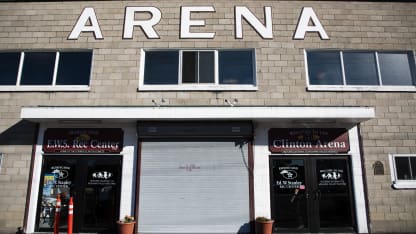
© Patrick McDermott
\\*
FRIGID BEGINNING
"The reason why I like those [Kraft Hockeyville] games and love what the league's done there, is because I think it just brings out the kid in us. It's really cool when you get to go back and remember being that kid on that side of the glass. It's a lot of fun."
Blue Jackets captain Nick Foligno didn't make the trip to Clinton, N.Y., but is a big fan of the Kraft Hockeyville experience. Raised outside of Buffalo, he and brother Marcus (Minnesota Wild) followed in their father, Mike's, footsteps to the NHL.
Their journey started, however, at a rink in DePew, N.Y., a Buffalo suburb. Here's how Nick describes those days:
"I played for the DePew Saints. They're just outside of Buffalo and they're called the Buffalo Saints now, but it was in DePew, N.Y. I'll never forget it, because the one side of the rink was open. In the winter, if the snow was blowing hard enough, it would come in. It had all these see-through sheets over it and the Zamboni would go through a little slit in the sheets. They could keep most of the snow out, but it was open, so it was freezing cold. I'll never forget it. Freezing cold rink."
"I was either three or four. My [house] team was actually the Pittsburgh Penguins, who now I hate. It's pretty funny how it works, right? You just remember those things and the jersey. I think I still have the jersey at home somewhere in a box. Marcus was on the Dallas Stars. It's pretty funny how you remember these things."
"The reason why I like those [Kraft Hockeyville] games and love what the league's done there, is because I think it just brings out the kid in us - especially during preseason. They do such a good job with the kids there, too. You get to actually interact with them and sign autographs. Having kids of my own, that's what you love about the game. It's really cool when you get to go back and remember being that kid on that side of the glass. It's a lot of fun."
\\*
ENTER SANDMAN
"When you're small, you think 'This is, like, the biggest place ever.' Now I go out there and skate, and it just feels like a shoebox."
During the offseason in his hometown of Kamloops, B.C., Riley Nash still takes a few spins on a couple rinks from his past. One is the Sandman Center, home rink to the Western Hockey League's Kamloops Blazers. The other is Brocklehurst Arena, a tiny rink that seats no more than a couple hundred.
Here's how the newly-acquired Blue Jackets center describes both:
"We have a junior team back home that has a rink that seats like 5,000, but growing up, you'd always play in these small little rinks that could hold a couple hundred people, maybe. It's small ice. But then, every once in a while, you'd get to play on the big surface - or so we thought, right?"
"I just thought that was the coolest thing, being able to play on the ice that I grew up watching the junior team playing on. I thought they were the greatest thing on earth, so being able to skate and play on the same ice they did, I thought that was just the coolest thing. I still skate there every once in a while, and now I go in there, after playing in NHL buildings - it's a little different going back there now."
"The first rink I skated on, though [Brocklehurst], only had like two rows of stands that seated maybe 100 people - and you could also stand around the glass. If you had what you thought was a big game, there'd be like 150 or 200 people there, mostly parents, family and friends.
"It's tiny. It's older. Small. It's a 30-second walk from where I lived, so you'd just walk over and skate when they had public skating there. I grew up on that ice, so back in the day when you're small, you think, 'This is like the biggest place ever.' Now I go out there and skate, and it just feels like a shoebox."
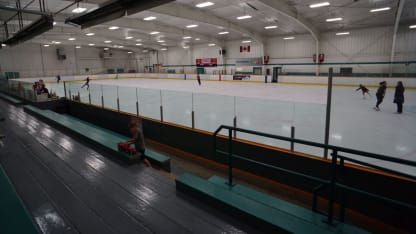
\\*
GOD SAVE THE QUEEN
"That's something you don't see too often anymore, a big mural of the Queen."
Blue Jackets defenseman Scott Harrington was like a lot of boys who grow up in Kingston, Ont. He played youth hockey and went to the local OHL team's home games on Friday nights at Memorial Centre Arena. When he thinks back to the early days, Harrington thinks about Kingston, that arena and his NHL dreams.
Here's how he describes it:
"When you're that age, 10-years old, all you think about is hockey. That was the thing to do on the weekend, Friday nights, going to the junior game. I'm in Toronto now for the offseason, so I haven't skated in Kingston in years. I think what's kind of interesting about it, because you don't see it in as many hockey rinks in Canada anymore, is we always had a big picture of the [Queen of England] at one end.
"Even going back to Sudbury [Ont.] this summer to play in [Foligno's] charity game, Nick got an older junior rink there and there was a picture of the Queen there - which was kind of funny. I'd kind of forgotten about that. Ours was huge. Like, it was massive. Hung at the one end. I thought that was different, because you don't see that in any rinks in America, obviously. But Canada, with its ties overseas, I think that was pretty much a staple in all the rinks whenever they were first built. That's something you don't see too often anymore, the big mural of the Queen."
"I remember getting to come back to Memorial Centre when I played for London, playing in Kingston. It seemed like everything had come full circle. Now I was the one playing in the junior game on Fridays. It was really fun."
\\*
GOOD OL' GPCR
"The glass, you can't really see. The ceiling is really low. And when you walked in, it just smelled like a hockey rink - one of those youth rinks. The locker rooms were tiny. It was just a fun place to play."
Defenseman Zach Werenski had several local rinks to pick from growing up in Grosse Pointe, Mich., a suburb of Detroit. The one he skated at most starting out is simply called GPCR Ice Rink.
Here's what he loves most about it:
"I can still remember some of the goals I scored at GPCR, when I was a really young kid. I remember getting a new stick, just going out there and shooting around or going to see high-school games there. I went there for a lot of different occasions.
"It's not a 'nice' rink by any means. It's all foggy when you get in there in the mornings. The glass, you can't really see. The ceiling is really low. And when you walked in, it just smelled like a hockey rink - one of those youth rinks. The locker rooms were tiny. It was just a fun place to play, though. It's where I grew up playing hockey and it's where I learned how to play … and I love going back there."
"That's the best rink to play on, the most fun rink. You come out here to [Nationwide Arena] and it's awesome when the stands are full, and it's the coolest thing in the world to play in the NHL but going back to those rinks where you grew up playing, it just sort of feels like old-time hockey."
\\*
LUNCH ON THE FLY
"I'll never forget my dad would have my skates at the rink and my lunch at the rink … he'd have it ready on his desk and I'd eat as fast as I could. Then I'd tie my skates, put my helmet on and get on the ice."
Pierre-Luc Dubois' first put on hockey skates and conquered the ice in Germany, when his father, Eric, was a player in Europe. After they moved back to Quebec and his dad began coaching in the Quebec Major Junior Hockey League (QMJHL), Dubois' rink was home to his dad's team, Baie-Comeau Drakkar.
Here's his recollection of those days:
"For me, when I think about 'my rink' growing up in Baie-Comeau, it's called the 'Centre Henry-Leonard,' so when I think of my first rink I think of that one. I went to elementary school like a 30-second walk from the rink, so for lunch I would run to the rink. My dad would have my lunch ready. I'd eat it in like two minutes, tie my skates, go on the ice for maybe an hour and then he'd be like, 'OK, you've got to go back to school now.' For me, that's one of the best memories I have of playing."
"What I remember about it, it's funny to say but maybe just the smell of it and just, like, being out there alone. I was alone out there all the time. My dad would be doing video or something, and sometimes he'd come past, sometimes some of his players were there, but often it was just me out there alone, just hearing the echo a little bit. Hitting the post and hearing the echo was fun.
"But I'll never forget my dad would have my skates at the rink and my lunch at the rink. He had a microwave [in his office], so I'd eat whatever we'd eaten the night before, the leftovers. He'd heat it up, because he knew I would be there at 11:20 a.m., so he'd have it ready on his desk, and I'd eat as fast as I could. Then I'd tie my skates, put my helmet on and get on the ice. That was first grade to fifth grade. That's where it started."
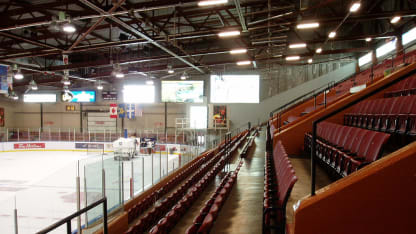
\\*
ORANGE STICKS AND WHITE SNOW
"Sometimes you couldn't see the puck or see anything really. The snow was that high."
Rookie forward Jonathan Davidsson got his first taste of skating at an outdoor rink, along with younger brother, Marcus, who's now a Sabres prospect. Jonathan, who's playing against the Sabres on Tuesday in Clinton, remembers snow falling, frigid temperatures and pucks that disappeared into white snowdrifts.
Here's how he recalls it:
"My first rink didn't even have a roof, because back in Sweden it was so cold and during the winter we didn't have to have a roof over the ice. The rink is called Tyreso Ice Hockey rink."
"I was about 3 or 4 years old and I'd go with my parents and my brother. I remember how dark it was outside and the lights coming down. I remember my first stick was a tree stick, an orange wooden stick - and it had Mats Sundin's curve on it. My brother had one, as well.
"The rink didn't have a roof, so we'd get a lot of snow there. It was always snowing, too, when we were on the ice. Sometimes you couldn't see the puck or see anything really. The snow was that high. I was too young to shovel it but my dad used to shovel it off.
"It's not like that in Sweden anymore. It's getting hotter, so that's sad, but I remember back in the day what it was like. It was a special feeling."
\\*
HAND-WARMERS AND HOCKEY GLOVES
"That's the way hockey should be played. Middle of winter. Freezing cold. The ice is nice and hard and you're out there with your family, your brothers, mom and dad, and your friends. Those are the experiences I cherished growing up."
Cam Atkinson also began his career outside, growing up in Riverside, Conn. Skating at the local outdoor rink for family outings and youth games, he remembers it both fondly and frigidly.
Here's how Atkinson got his start:
"I grew up playing on an outdoor rink in my hometown, the Greenwich Skating Club, so we had our [hard] skates at 5:30 or 6 in the morning in the middle of winter, when it was freezing and you had to put hand and feet warmers in your skates and gloves. That was my experience growing up. I started skating when I was 2, but I remember being 4 or 5 years old, going all the way to probably 10 or 11 at that rink.
"I remember the free skates in the winter, when it was snowing. That's the way hockey should be played. Middle of winter. Freezing cold. The ice is nice and hard and you're out there with your family, your brothers, mom and dad, and your friends. Those are the experiences I cherished growing up."
"In different situations, you kind of reminisce about the past. I've got so much going on now that I don't really think about growing up, but I'd love to bring my [baby] boy, Declan, there - start him on the outdoor rink."
\\*
THE OLD BARN IN DUNNVILLE
"It was just a wooden barn. They'd even had fires in it. When you walked in, it smelled like popcorn and vinegar. Goodness, it was bad."
It's gone now, torn down after decades of kids learning to skate at the old Dunnville Arena, which stood along the waterfront in Dunnville, Ont. It was a building, however, that will always be remembered fondly by Bill Davidge - studio analyst for Blue Jackets television broadcasts.
Davidge got his start in hockey there, in a "barn" that helped him springboard from Dunnville to Ohio State to a coaching stint at Miami of Ohio and careers in scouting and broadcasting.
"It wasn't until I was about 9 or 10 that we finally they got the artificial ice in there. They'd put it in around Sept. 15 or so, and then take it out once April 1 came along. It was never back in during the summer because our small town could use that rink for a lot of different sports. We played lacrosse and everything else in there."
"It was just a wooden barn. They'd even had fires in it. When you walked in, it smelled like popcorn and vinegar. Goodness, it was bad. They took it down, but it was right on the river in our hometown and there was a feed mill right beside it. It was just called the Dunnville Arena - no corporate name, no advertising.
"I was five or six when I first played there. Anytime you could get off the outdoor rinks and the rivers and ponds, and you got a chance to play organized hockey, that was special. You paid a quarter every time you practiced or played, and I'll never forget, they had a $2 registration fee. Two bucks. That basically was your insurance policy if you ever got hurt. It was pretty neat."



